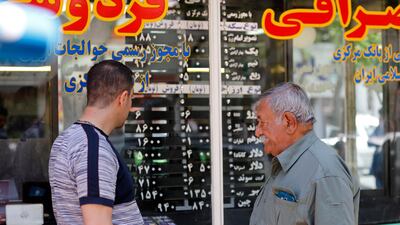With a plane ticket booked, graphic designer Najmeh Mohammadi headed to the currency traders on Tehran’s Manouchehri Street at 6am on Tuesday for the dollars that she needed for overseas travel. By midday, she was still waiting and fast losing hope.
The 35 year old was among those hoping to buy the US currency at a new rate of 42,000 rials set hours earlier by authorities who are trying to stem a sharp decline in the local currency that is concerning business and political circles. The immediate effect of the late-night announcement was confusion and a freezing up of trades as dealers awaited instructions from the central bank.
“I may have to cancel my trip,” said a resigned Ms Mohammadi.
As Iran's confrontation with the Trump administration and its regional allies heats up, its rulers are attempting to avert a currency crisis that would add to their domestic woes. But in a country with a complex foreign exchange system and a substantial black market that are regularly buffeted by factional feuding and geopolitical tension, finding a solution is not easy.
In parliament on Tuesday, central bank governor Valiollah Seif pointed the finger at Iran’s foes, saying: “Enemies outside of our borders, in various different guises, are fuelling this issue and are going to some effort to make conditions tougher for the people.”
_______________
Read more:
Iran clamps ceiling on dollar holdings in effort to support rial
_______________
The escalating stand-off with America – which takes in Tehran’s support for Syria’s Bashar Al Assad as well its material support to Yemen’s Houthi rebels – is threatening the longevity of an already under-performing 2015 nuclear deal that underpins the Iranian government’s economic agenda.
President Donald Trump has set a May 12 deadline for his decision on whether to stick with the pact and filled two senior roles in his administration with Iran hawks who oppose it.
Other officials in Iran President Hassan Rouhani's government say there is no economic rationale for the currency slide, and have suggested conservative opponents are fuelling it to discredit the administration.
“One of Rouhani’s main first-term achievements was to stabilise the foreign-exchange market even before his second achievement, the nuclear deal, was concluded,” said Ali Vaez, senior Iran analyst at International Crisis Group. “Now both are crumbling. Whether Rouhani’s rivals are contributing to the fiasco or not, they are benefiting from it.”
Mr Rouhani won power in 2013 with a vow to repair an economy hollowed out by international sanctions imposed over Iran’s nuclear programme. The currency had plummeted in the last years of his predecessor’s rule, while inflation soared above 40 per cent. He stabilised the rial and prices early on, and then sealed the agreement to re-enter the global economy.
Yet, the rewards the pact promised have not arrived, with investors wary of infringing remaining US curbs linked to the Islamic republic's missile development and its ties to groups designated as terrorists by some Western nations. Iranians have grown increasingly irate over the slow pace of change, leading to days of anti-government protests from late December.
The new rate for the dollar – which had previously sold for 49,500 rials – was in large part intended to quash the black market. There, it had recently been trading for 60,000 rials, a 50 per cent drop from a year ago, putting pressure on official rates.
On Wednesday, police said they arrested 12 people selling currency illegally and identified a group running an online operation without a license, the semi-official Tasnim news agency reported.
Over at one of Tehran's licensed foreign-exchange offices, there was still no business. Government spokesman Mohammad Bagher Nobakht said it could take "two or three days" for circulars to reach all dealers.
Mr Seif, the bank's governor, told parliament on Tuesday that Iran had enough foreign-exchange reserves to meet demand and that volatility could not be explained by economic factors.
One of the underemployed Manouchehri Street traders, Hamid, saw it differently. “Ordinary people feel the dollar is a better investment,” he said.

